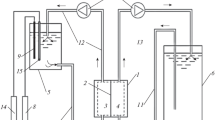Summary
(3H)DIDS (4,4′-diisothiocyano-2,2′-ditritiostilbene-disulfonate) was used as a convalent label for membrane sites involved in anion permeability. The label binds to a small, superficially located population of sites, about 300,000 per cell, resulting in almost complete inhibition of anion exchange. The relationship of biding to inhibition is linear suggesting that binding renders each site nonfunctional. In the inhibitory range less than 1% of the label is associated with lipids but at higher concentrations of DIDS, the fraction may be as high as 4%. In ghosts, however, treatment with (3H)DIDS results in extensive labeling of lipids. In cells, a protein fraction that behavens on SDS acrylamide gels as thought its molecular weight is 95,000 daltons (95K) is predominatly labeled by (3H)DIDS. The only other labeled protein is the major sialoglycoprotein which contains less than, 5% of the total bound (3H)DIDS. Because of the linear relationship of binding to inhibition and the unique architecture of the site, it is suggested that the (3H)DIDS-binding site of the 95K protein is the substrate binding site of the anion transport system. The 95K protein is asymmetrically arranged in the membrane with the sites arranged on the outer face accessible to agent in the medium. In “leaky” ghost, only a few additional binding sites can be reached from the inside of the membrane in the 95K protein, in contrast to the extensive labeling of other membrane proteins in ghosts as compared to cells.
Similar content being viewed by others

Abbreviations
- DADS:
-
4,4′-Diamino-2,2′-dihydrostilbene disulfonic acid
- DIDS:
-
4,4′-Diisothiocyano-2,2′-stilbene disulfonic acid
- (3H)DADS:
-
4,4′-Diamino-2,2′-ditritiostilbene disulfonic acid
- (3H)DIDS:
-
4,4′-Diisothiocyano-2,2′-ditritiostilbene disulfonic acid
References
Bale, W. F., Helmkamp, R. W., Davis, T. P., Izzo, M. J., Goodland, R. L., Contreras, M. A., Spar, I. L. 1966. High specific activity labelling of protein with131I by the iodine monochloride method.Proc. Soc. Exp. Med. 122:407
Bender, W. W., Garan, H., Berg, H. C. 1971. Proteins of the human erythrocyte membrane as modified by pronase.J. Mol. Biol. 58:783
Bretscher, M. S. 1971. Human erythrocyte membranes: Specific labelling of surface proteins.J. Mol. Biol. 58:775
Bretscher, M. S. 1972. Phosphatidylethanolamine: Differential labelling in intact cells and cell ghosts of human erythrocytes by a membrane-impermeable reagent.J. Mol. Biol. 71:523
Cabantchik, Z. I., Rothstein, A. 1972. The nature of the membrane sites controlling aniton permeability of human red blood cells as determined by studies with disulfonic stilbene derivatives.J. Membrane Biol. 10:311
Cabantchik, Z. I., Rothstein, A. 1974. Membrane proteins related to anion permeability of human red blood cells. II. Effects of proteolytic enzymes on disulfonic stilbene sites of surface proteins.J. Membrane Biol. 15:227
Dodge, J. T., Mitchell, C., Hanahan, D. 1963. The preparation and chemical characteristics of hemoglobin free ghosts of human erythrocytes.Arch. Biochem. Biophys. 110:119
Fairbanks, G., Steck, T. L., Wallach, D. F. H. 1971. Electrophoretic analysis of the major polypetides of the human erythrocyte membrane.Biochemistry 10:2806
Gunn, R. B., Dalmark, M., Tosteson, D. C., Wieth, J. O. 1973. Characteristics of chloride transport in human red blood cells.J. Gen. Physiol. 61:185
Hamaguchi, H., Cleve, H. 1972. Solubilization of human erythrocyte membrane glycoproteins and separation of the MN glycoprotein from a glycoprotein with I, S, and A activity.Biochim. Biophys. Acta 278:271
Hoogeween, J. T., Juliano, R., Coleman, J., Rothstein, A. 1970. Water-soluble proteins of the human red cell membrane.J. Membrane Biol. 3:156
Itzhaki, R. F., Gill, D. M. 1964. A microbiuret method for estimating proteins.Analyt. Biochem. 9: 401
Juliano, R. L., Rothstein, A. 1971. Properties of an erythrocyte membrane limpoprtotein fraction.Biochim. Biophys. Acta 240:227
Knauf, P. A., Rothstein, A. 1971. Chemical modification of membranes. I. Effect of sulfhydryl and amino reactive reagents on anion and cation permeability of the human red blood cell.J. Gen. Physiol. 58:190
Maddy, H. 1964. A fluorescent label for the outer components of the erythrocyte membrane.Biochim. Biophys. Acta 88:390
Phillips, D. R., Morrison, M. 1971. Exposed protein on the intact huma erythrocyte.Biochemistry 10:1766
Resch, K., Imm, W., Ferber, E., Wallach, D. F. H., Fischer, H. 1971. Quantitative determination of soluble and membrane protein through their native fluorescence.Naturwissenschaften 58:220
Rosenberg, S. A., Guidotti, G. 1968. The protein of human erythroocyte membranes. I. Preparation solubilization and partial characterization.J. Biol. Chem. 243:1985
Rothstein, A., Cabantchik, Z. I. 1973. Protein structures involved in the anion permeability of the red blood cell membraneIn: Comparative Biochemistry and Physiology of Transport. K. Block, L. Bolis and E. S. Luria, editors. North Holland Publishing Co. (In press)
Schulte-Frohlinde, D., Blume, H., Gusten, H. 1962. Photochemical cis-trans isomerization of substituted stilbnes.J. Phys. Chem. 66:2486
Segrest, J., Kahane, I., Jackson, R. L., Marchesi, V. T. 1973. Major glycoprotein of the human erythrocyte membrane: Evidence for and amphipathic molecular structure.Arch. Biochem. Biophys. 155:1973
Steck, T. L. 1972. Crosslinking the major proteins of the isolated erythrocyte membrane.J. Mol. Biol. 66:295
Tanner, M. J. A., Boxer, O. J. 1972. Separation and some properties of the major proteins of human erythrocyte membhranes.Biochem. J. 129:333
Triplett, R. B., Carraway, K. L. 1972. Proteolytic digestion of erythrocytes, released ghosts and isolated membranes.Biochemistry 11:10
Author information
Authors and Affiliations
Rights and permissions
About this article
Cite this article
Cabantchik, Z.I., Rothstein, A. Membrane proteins related to anion permeability of human red blood cells. J. Membrain Biol. 15, 207–226 (1974). https://doi.org/10.1007/BF01870088
Received:
Issue Date:
DOI: https://doi.org/10.1007/BF01870088



